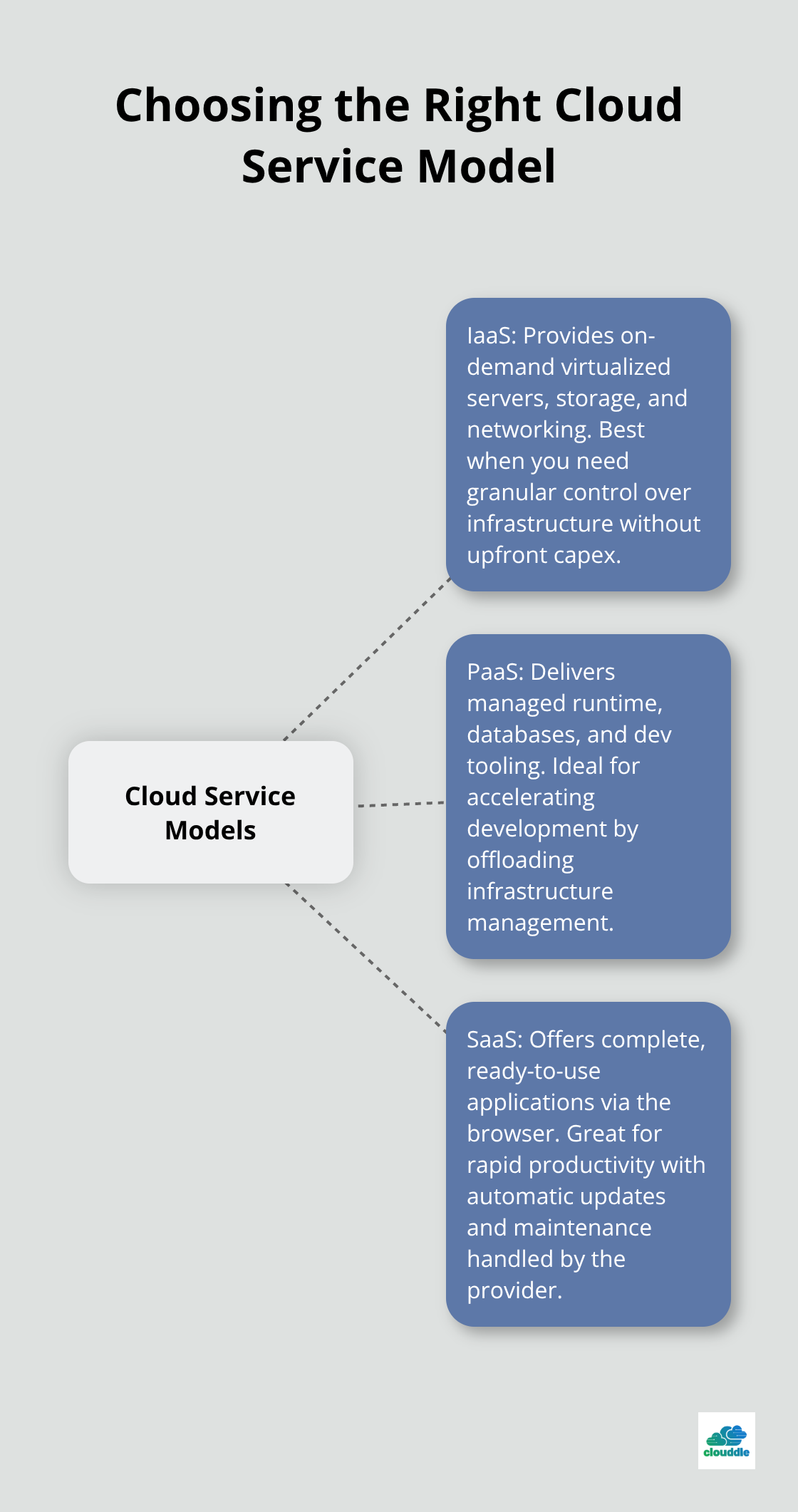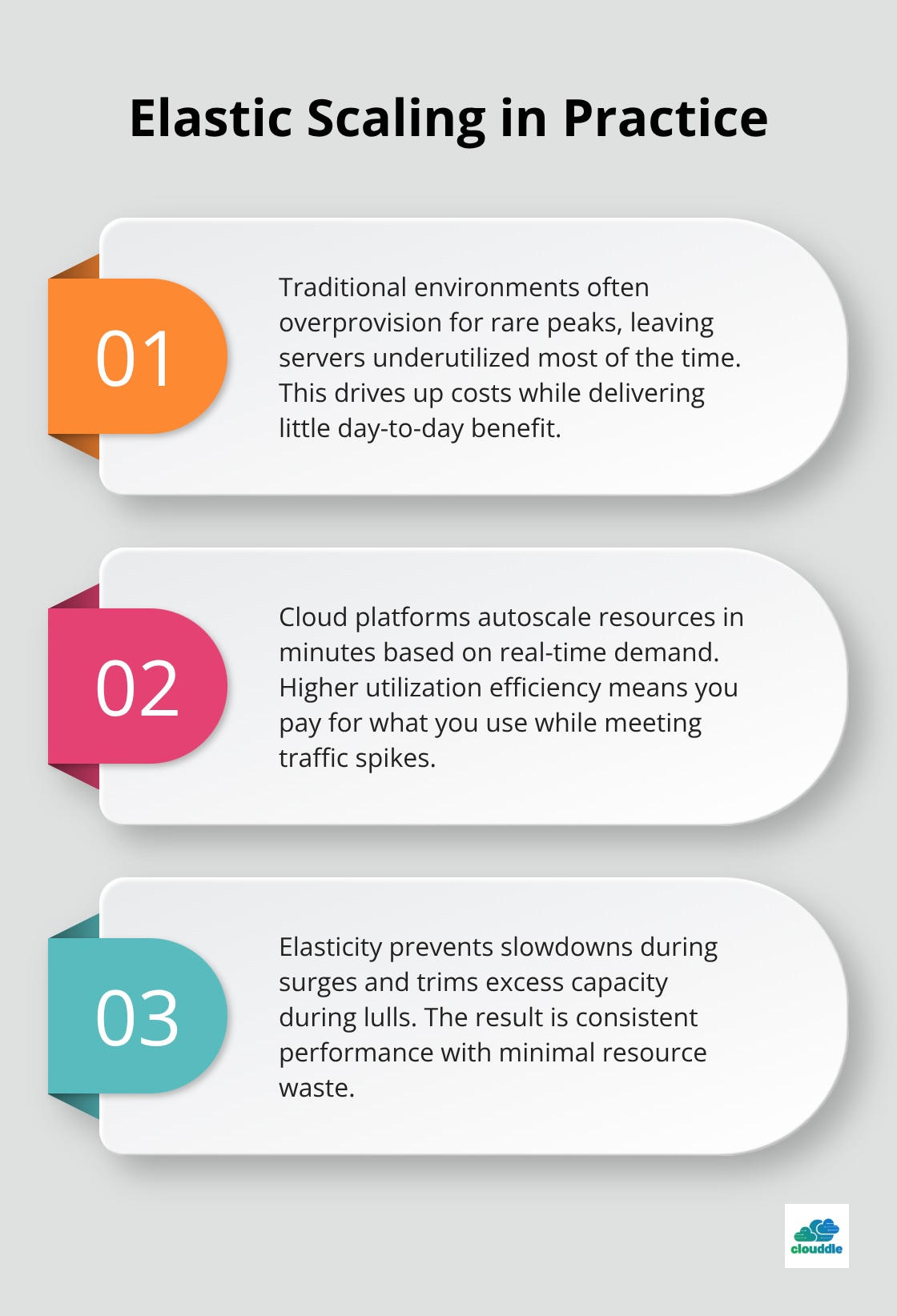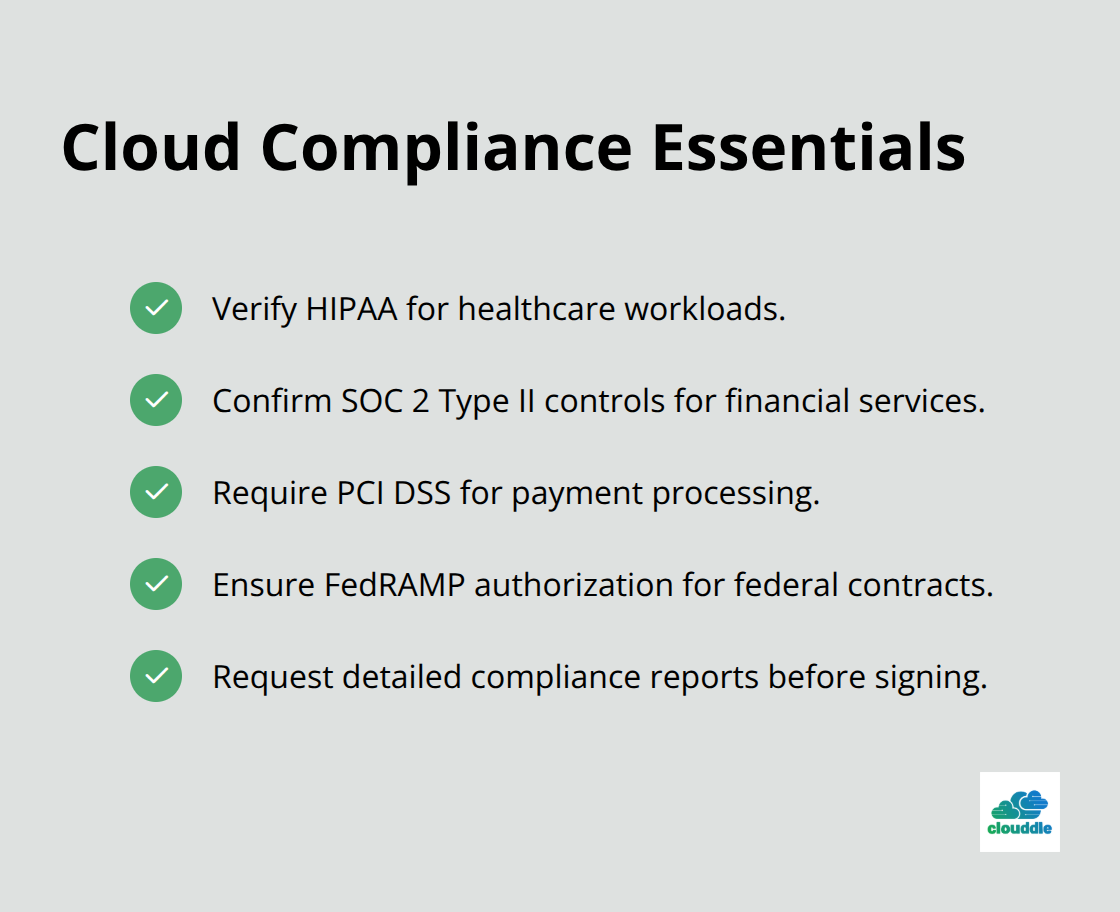Modern businesses face mounting pressure to modernize their IT infrastructure while controlling costs. Cloud infra IT solutions have emerged as the definitive answer to this challenge.
We at Clouddle see companies transform their operations daily through strategic cloud adoption. The shift from traditional on-premises systems to cloud-based infrastructure delivers measurable improvements in efficiency, security, and scalability.
Which Cloud Service Model Fits Your Business
Infrastructure as a Service (IaaS) Platforms
Infrastructure as a Service delivers raw computing power through virtualized hardware resources like servers, storage, and networking components. This foundational cloud model enables organizations to access enterprise-grade infrastructure without significant upfront capital investment.
Companies gain immediate access to enterprise-grade hardware without capital investment. Resources scale up or down based on demand fluctuations, eliminating the need for costly hardware purchases during peak periods.
Platform as a Service (PaaS) Options
Platform as a Service accelerates application development through pre-configured development environments, databases, and middleware. Microsoft Azure and Google Cloud Platform dominate this space, offering developers ready-to-use frameworks that eliminate infrastructure management overhead.
Development teams focus on code creation rather than server maintenance. PaaS providers handle security patches, updates, and system monitoring (freeing internal resources for strategic projects).
Software as a Service (SaaS) Applications
Software as a Service delivers complete applications through web browsers, providing organizations with ready-to-use software solutions. This model removes software installation, maintenance, and update responsibilities from internal IT teams.
Users access applications instantly from any device with internet connectivity. Automatic updates ensure teams always work with the latest features and security patches (without IT intervention required).
Each service model serves specific operational needs: IaaS provides infrastructure control, PaaS enables rapid development cycles, and SaaS offers immediate productivity gains. The choice between these models depends on your technical expertise, budget constraints, and operational requirements.

How Cloud Infrastructure Transforms Business Economics
Cloud infrastructure fundamentally reshapes business economics through measurable cost reductions and operational flexibility. Companies that adopt cloud services report significant infrastructure cost savings within the first year, while major cloud platforms help reduce total cost of ownership. The elimination of hardware procurement cycles removes capital expenditure spikes that typically range from tens of thousands to hundreds of thousands of dollars for enterprise-grade servers. Organizations also eliminate facility costs for server rooms, which can be substantial in major metropolitan areas.
Elastic Scaling Eliminates Resource Waste
Traditional infrastructure forces businesses to overprovision for peak demand, which results in suboptimal server utilization rates. Cloud platforms automatically adjust resources based on real-time demand and achieve higher utilization efficiency. During peak shopping periods, retailers that use cloud platforms can scale their resources dramatically within minutes, then scale back immediately after peak traffic subsides. This elasticity prevents both performance bottlenecks during high-demand periods and resource waste during slower periods.

Advanced Security Exceeds Enterprise Standards
Cloud providers invest billions annually in security infrastructure that individual companies cannot match. Major cloud platforms operate numerous compliance certifications including SOC 2, HIPAA, and PCI DSS while maintaining exceptional uptime across their security systems. Multi-factor authentication, encryption at rest and in transit, and automated threat detection come standard with major cloud platforms. Companies report significantly fewer security incidents after migrating to cloud infrastructure, primarily due to automated patch management and continuous oversight capabilities.
Remote Work Capabilities Drive Productivity
Cloud-based collaboration tools enable seamless remote work that traditional infrastructure cannot support effectively. Teams that use cloud-based productivity suites report faster project completion times compared to on-premises alternatives. Real-time document collaboration, video conference integration, and mobile device synchronization happen automatically through cloud platforms. Organizations with cloud infrastructure experienced substantially less productivity loss during remote work transitions compared to companies that relied on traditional IT systems, demonstrating the clear advantage of cloud adoption.
These economic advantages create a compelling case for cloud adoption, but successful implementation requires careful evaluation of specific business requirements and technical considerations.
What Makes or Breaks Cloud Infrastructure Success
Security compliance requirements determine which cloud providers can support your business operations. Organizations in healthcare must verify HIPAA compliance, while financial services need SOC 2 Type II certifications and PCI DSS standards. Government contractors require FedRAMP authorization, which only select cloud providers maintain.

Major cloud platforms like AWS and Microsoft Azure offer compliance documentation, but smaller providers often lack comprehensive certifications. Request detailed compliance reports before you sign contracts, as non-compliance can result in substantial fines depending on your industry.
Legacy System Integration Challenges
Most businesses operate legacy applications that cannot migrate to cloud platforms immediately. ERP systems, custom databases, and specialized software often require hybrid cloud architectures that bridge on-premises and cloud environments.
Companies report that a significant portion of their applications need modifications before cloud migration. Direct integration through APIs works for modern applications, while legacy systems may require middleware solutions or virtual private networks. Test integration thoroughly to prevent operational disruptions that can cost thousands of dollars per hour of downtime.
Provider Performance Standards Matter
Cloud provider uptime guarantees vary significantly, with enterprise-grade services that offer higher uptime compared to basic plans. The difference in downtime can be substantial between service tiers.
Response time commitments also differ dramatically between providers. Some guarantee four-hour response times while others offer 24-hour windows. Support quality varies based on service tiers, with premium support that provides dedicated technical account managers compared to shared support queues.
Evaluate provider track records through third-party services rather than rely solely on claims, as actual performance often differs from advertised specifications.
Final Thoughts
Cloud infra IT solutions represent the most significant infrastructure advancement for modern businesses. Companies eliminate massive capital expenditures while they gain access to enterprise-grade security that exceeds what most organizations can build internally. The flexibility to scale resources instantly prevents both performance bottlenecks and resource waste.
Strategic implementation requires careful planning around compliance requirements and legacy system integration. Organizations must evaluate provider performance standards thoroughly, as uptime guarantees and support quality vary dramatically between service tiers (testing integration capabilities prevents costly operational disruptions during migration). Companies that delay cloud migration risk falling behind competitors who leverage these operational efficiencies.
The future points toward increased cloud adoption as businesses recognize the competitive advantages. We at Clouddle help businesses navigate this transformation through comprehensive technology solutions that combine networking, security, and managed IT services. Organizations that embrace cloud solutions now position themselves for sustained growth in an increasingly digital marketplace.


